#do ho suh
Explore tagged Tumblr posts
Text


Home within Home within Home within Home within Home by Do Ho Suh.
4K notes
·
View notes
Text


'cause + effect' by do ho suh in house of cards: an exhibition of contemporary sculpture in response to chardin - christie's at the rothschild collection at waddesdon manor (2012)
2K notes
·
View notes
Text
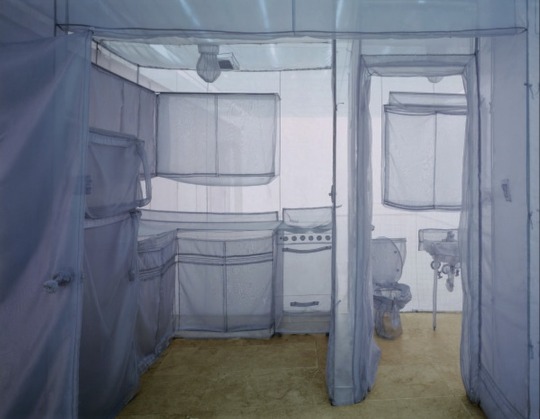
Do Ho Suh: 'The Perfect House Il' (2003)
2K notes
·
View notes
Text

Do Ho Suh | Aesthetica
86 notes
·
View notes
Text


48 WEST 22ND STREET, APT. A, CORRIDOR & STAIRCASE, NEW YORK NY 10011, USA, (2012) & STAIRCASE III (2003-2011) BY DO HO SUH
50 notes
·
View notes
Text
instagram
Do Ho Suh. Toilet, 2013.
21 notes
·
View notes
Photo




Sweet Notes poses with an artwork at Battersea Power Station tube stop.
In London, England.
This is called Routes/Roots: London . By Do Ho Suh. Dated 2022 .
A bit about it - this is from https://art.tfl.gov.uk/projects/routes-roots-london/
Art on the Underground are pleased to present the 37th commission for the pocket Tube map cover by London-based artist Do Ho Suh.
Do Ho Suh has created an embroidered facsimile of the iconic Tube map design focusing on the routes that he habitually uses around his home and studio. The work, titled Routes/Roots: London, connects to the artist’s interest in ideas of expanded domestic space. For Suh, the concept of ‘home’ encompasses the built environment and a conceptual space; a site of memory, imagining, and potential displacement. Home is an idea that speaks to us both as individuals and collectively in society. The commission comes at a time when most of us have been forced to question, or faced restrictions to travel, both local and international.
Central to Routes/Roots is an exploration of the patterns and idiosyncrasies of daily travel for everyone in London, during and following the pandemic. The Tube map cover connects to the new and old ways we navigate, the ways we move through and around the city.
Routes/Roots plays with the idea that the Tube map exists as a tool for rational navigation when in reality, we navigate according to more than just logic – often rerouting in favour of preferred neighbourhoods, quieter ones, to journey with others or to allow space for accidental errors or timetabling.
#My Little Pony#g1#sweet notes#art#embroidery#do ho suh#battersea#london#england#tube#london underground#underground#battersea power station
23 notes
·
View notes
Text





Seoul Home/Seoul Home/Kanazawa Home/Beijing Home/Pohang Home/Gwangju Home/Philadelphia Home (2012) by Do Ho Suh (Private collection)
For the past thirty years, the internationally acclaimed artist Do Ho Suh (born 1962), who left Korea to study in the United States in 1993, has sought to reconcile the multiple spaces he has occupied. Within Suh’s practice is a sense of longing from his peripatetic adulthood, connecting to feelings of displacement and disconnection from family that can be understood by anyone who has left people and places behind.
In 2012, Suh made a full-scale recreation of his family’s traditional Korean house (hanok) using diaphanous pale green translucent silk, a fabric commonly used to make hanbok, traditional Korean garments constructed with time-honored sewing techniques. One of the few of Suh’s fabric houses that are suspended from the ceiling (as opposed to freestanding), this work conjures feelings of nostalgia and the longing to return home, evoking pasts that can never be regained. Suh created this portable home that can easily travel with him as a way to grapple with his feelings of loss and nostalgia after leaving South Korea, and to provide a source of comfort when needed. For the artist, home is infinitely portable and transportable; home is everywhere and nowhere.
12 notes
·
View notes
Text
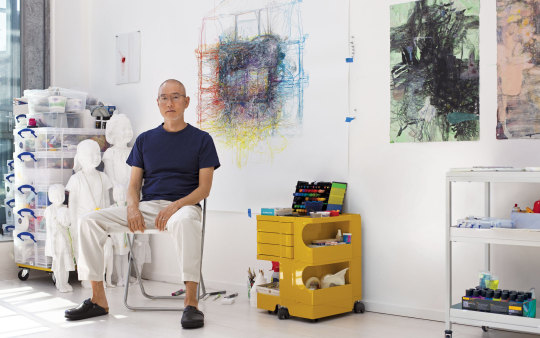
Photographed in his London studio, Do Ho Suh is seated next to unfinished works on paper, including a drawing from his “Scaled Behavior” series, made in collaboration with robots. PHOTO: GAUTIER DEBLONDE, source.
6 notes
·
View notes
Text


do ho suh in the fashion of architecture - bradley quinn (2003)
973 notes
·
View notes
Text
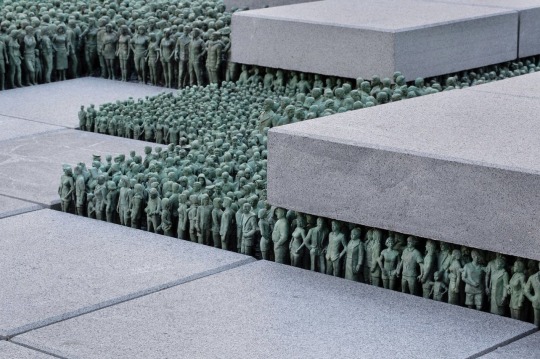

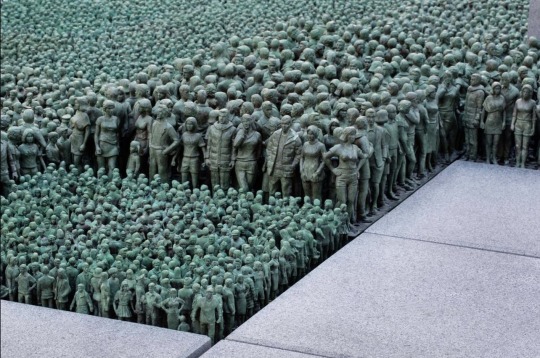

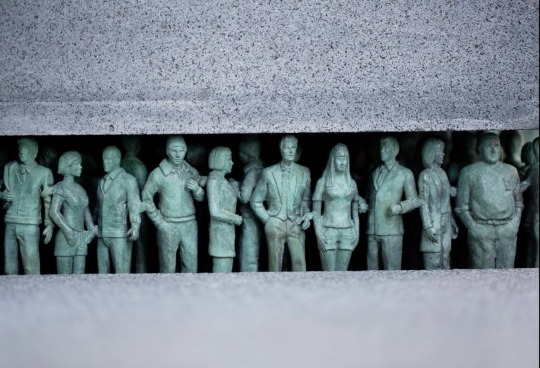
Do Ho Suh: Grass Roots Square (2012)
bronze sculptures cast next to each other and attached to a steel plate by welding. A lone tree is planted along with the sculptures. It is approx. 400 different human figures.
3K notes
·
View notes
Photo

Karma Juggler - Do Ho Suh (2007)
Red coloured pencil on paper
2 notes
·
View notes
Photo

Home Reframed
“The word home has many meanings,” writes Museum of the Home, a London-based gallery space which, since 2011, has been dedicated to the changing shape of domestic interiors over time. “It can be the physical space we live in, or a feeling that goes beyond a specific time or place.” Do Ho Suh (b. 1962) is a South Korean artist whose practice centres around these questions. Since the 1990s, Suh has become known for crafting large-scale fabric sculptures that recreate the places in which he has lived and worked. These pieces vary from small, singular household objects – door handles, plugs switches and light bulbs – through to full scale replicas of architectural spaces, apartments, staircases and hallways.



#do ho suh#artist#art#south korean artist#home reframed#museum of the home#large-scale fabric sculptures#sculptures
1 note
·
View note


